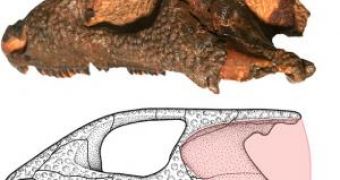The ear of a fish does not capture the sounds in the air and the first backboned species that conquered the land were largely deaf, lacking the tiny bones that transmitted the airborne sounds to the inner ear. Evolved hearing was believed to have evolved just before the emergence of dinosaurs, about 200 million years ago.
Now, a team has discovered that weasel-sized prehistoric reptiles from Russia belonging to a group called Parareptilia had the first modern ears 260 million years ago and they could have evolved more perfected hearing for living in the dark.
The scientists found the large-eyed fossils of Bashkyroleter mesensis with surprisingly advanced ears near the Mezen River (central Russia). Parareptilia were extremely primitive reptiles, extinct for a long time. The outside of the cheek in these species was covered with a big eardrum, connected with the inner ear (that receives sounds) by means of a bone similar to that found in the ears of modern reptiles, birds but also mammals, including humans.
Bashkyroleter, which lived during the Permian Period, belonged to at least six species that reached a maximum of about 1.5 feet (50 cm) in length and could hear the same sounds detected by modern lizards. "Animals with an excellent sense of hearing such as cats, owls, or geckos are all active at night or under low-light conditions. And maybe this is what these Permian reptiles did too.", said researcher Johannes Mueller, a vertebrate paleontologist at Humboldt University in Berlin.
The large eye sockets of the novel fossils point to large eyes, and trait typical to nocturnal vertebrates, thus these reptiles could have been amongst the first nocturnal land vertebrates, that did not require sunlight to get warm. "Although efficient hearing abilities and a nocturnal lifestyle seem to be nothing unusual in our modern world, they might have had revolutionary effects at this early time," co-author Johannes M?ller at the Natural History Museum of the Humboldt University in Berlin, Germany, told LiveScience.
"These reptiles are part of a completely extinct lineage distantly related to turtles, lizards, snakes, crocodiles, birds and dinosaurs. The advanced ears we see today are thought to have evolved mostly independently of each other. It would be interesting to investigate how often and when exactly modern ears evolved. For example, do the ears of modern lizards, crocodiles and birds have a common origin or not?", Mueller said.

 14 DAY TRIAL //
14 DAY TRIAL //